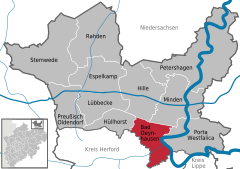Bad Oeynhausen
| Bad Oeynhausen | ||
|---|---|---|
 |
||
|
||
| Coordinates: 52°12′N 08°48′E / 52.200°N 8.800°ECoordinates: 52°12′N 08°48′E / 52.200°N 8.800°E | ||
| Country | Germany | |
| State | North Rhine-Westphalia | |
| Admin. region | Detmold | |
| District | Minden-Lübbecke | |
| Government | ||
| • Mayor | Klaus Mueller-Zahlmann (SPD) | |
| • Governing parties | SPD | |
| Area | ||
| • Total | 64.8 km2 (25.0 sq mi) | |
| Elevation | 45-269 m (−838 ft) | |
| Population (2015-12-31) | ||
| • Total | 48,990 | |
| • Density | 760/km2 (2,000/sq mi) | |
| Time zone | CET/CEST (UTC+1/+2) | |
| Postal codes | 32545, 32547, 32549 |
|
| Dialling codes | 05731, 05734 |
|
| Vehicle registration | MI | |
| Website | www.badoeynhausen.de | |
Bad Oeynhausen (German pronunciation: [ˈbat ˈøːnhaʊzn̩]) (Low German: Bad Öinusen) is a spa town on the southern edge of the Wiehengebirge in the district of Minden-Lübbecke in the East-Westphalia-Lippe region of North Rhine-Westphalia, Germany. The closest larger towns are Bielefeld (39 kilometres southwest) and Hanover (80 km east)
In the village of Bergkirchen, which belongs to Bad Oeynhausen, a wellspring sanctuary existed in pre-Christian (Saxon) times at the local crossing of the Wiehengebirge, which was replaced in the 9th century by a church. Today's church is a subsequent building. On the church and the downhill-situated Widukind spring plates explain this further. A few metres from the church a 13th-century timbered homestead can still be found.
In 753 Pepin the Short, according to the Frankish Chronicles, stopped over ad locum qui dicitur Rimiae, so that Rehme is commonly accepted as the oldest part of town. Another source describes Nero Claudius Drusus’ Germania campaigns and states that he once camped ad locum qui dicitur Rimi, which would date Rehme's proven existence as far back as 11 BC, but it is not officially accepted.
In 1745 a farmer named Sültemeyer was wondering about the salty crust on his pig's backs after wallowing in the mud. After public awareness of this finding King Frederick II of Prussia ordered the construction of a saltworks, which was named "Royal Saline Neusalzwerk". Today's Sültemeyer Fountain (colloquial: Pig-Fountain), in the city centre, is a reminder of the city's beginning.
From 1830 on the mining captain Carl Baron of Oeynhausen (1795–1865) oversaw drilling in today's spa garden area in search of salt deposits, but instead found a thermal salt spring in 1845. Quickly the healing abilities of this spring were discovered and first baths were built in the community, which now was called "Neusalzwerk near Rehme". In 1848 King Frederick William IV of Prussia renamed it to "Royal Bath (German: Bad) Oeynhausen", which was kept as the name after receiving its own town charter town in 1860. The opening of the Cologne-Minden railway line in 1849 connected the city with railroad network.
...
Wikipedia




